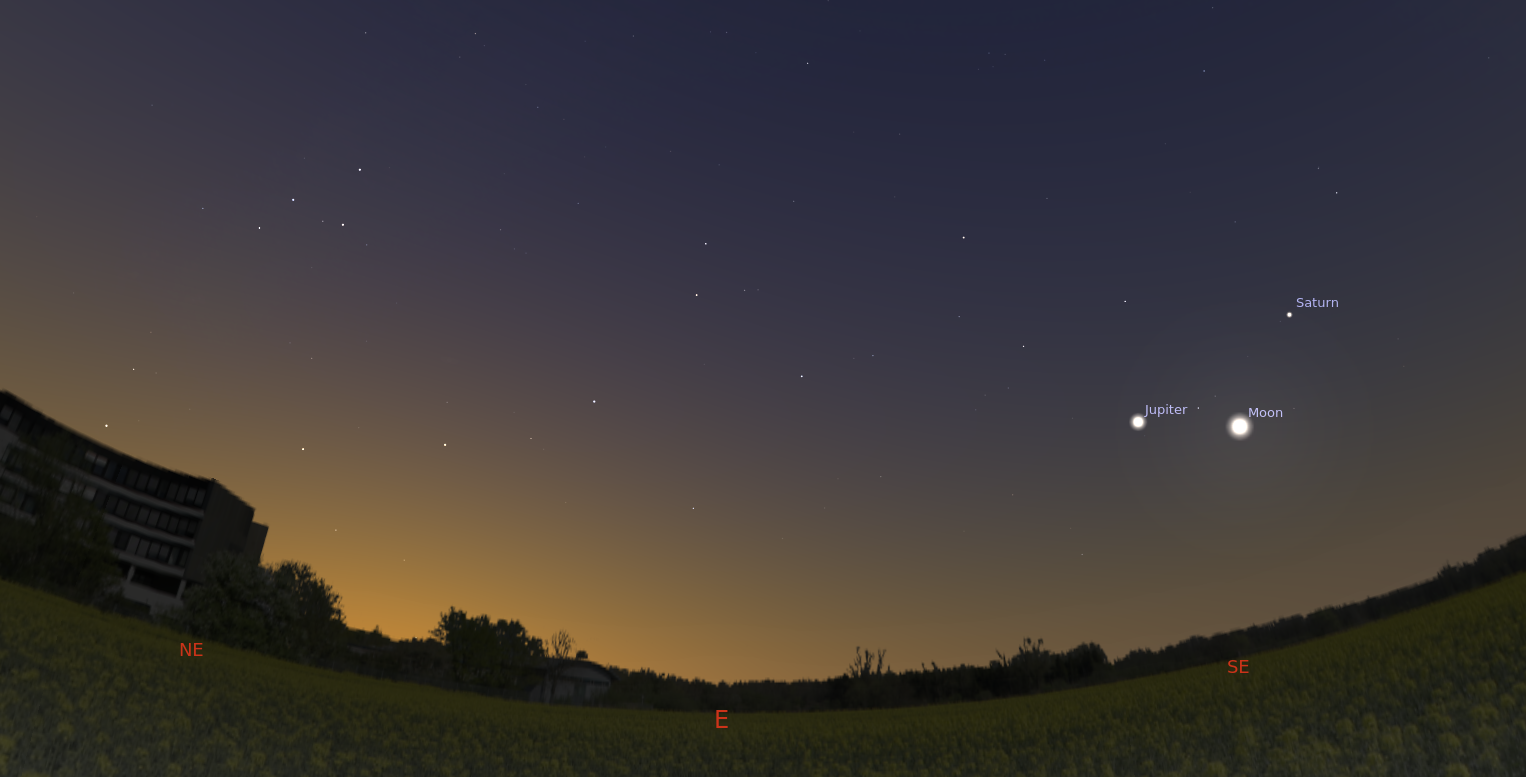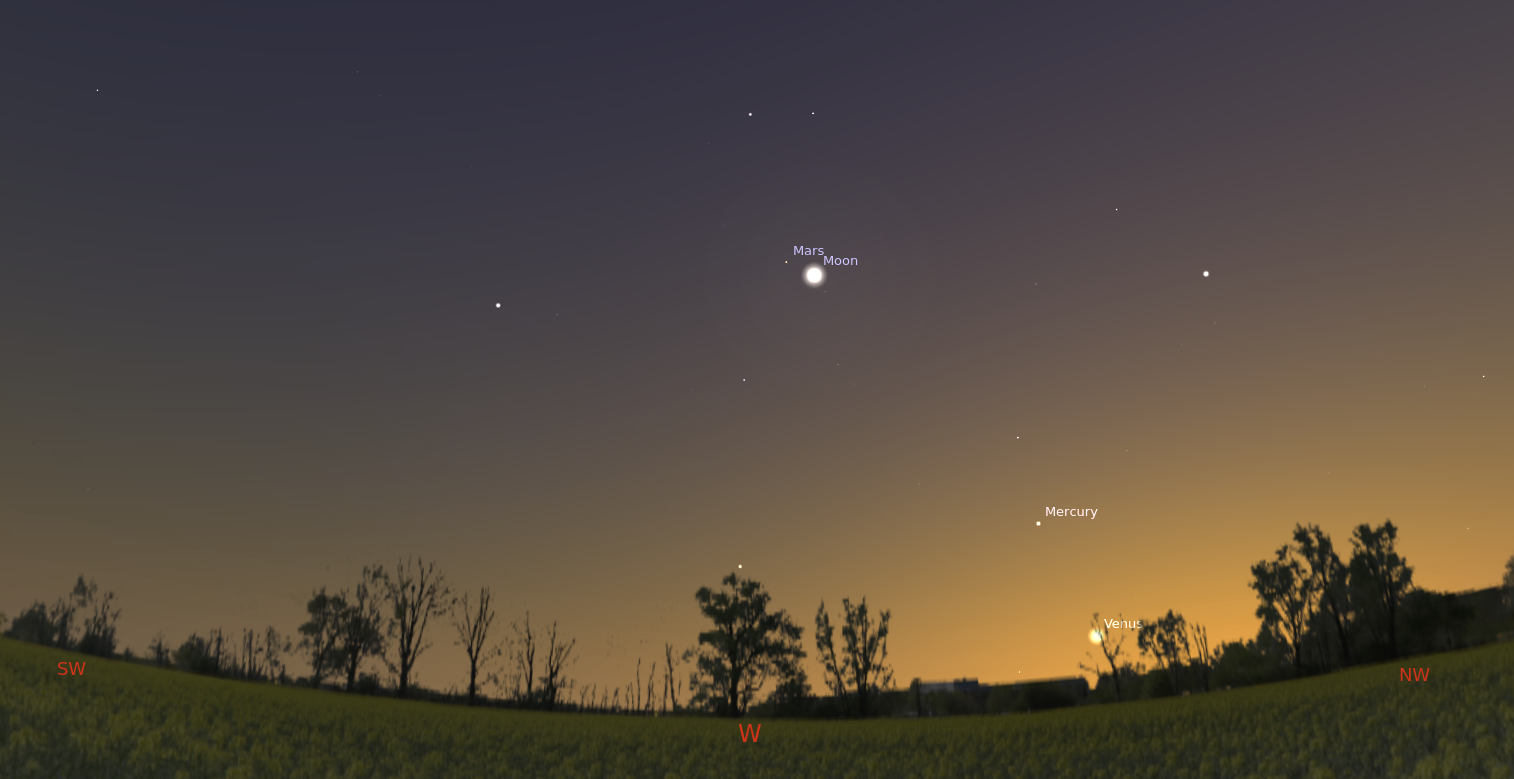The End of the Winter Intermission
April 23, 2021
Astronomical events have been somewhat sparse in recent months. There are no really impressive meteor showers in winter or spring, it has been some time since the last eclipse, and most of the planets have been hiding near the sun recently. But the action in the sky always waxes and wanes, and the present intermission in the drama is transitioning to the next act. Jupiter, Saturn, and Venus are all moving far enough from sun to be seen again, the pace of meteor showers will pick up a bit as spring passes into summer, and for a few hours in late May, the face of the moon will darken and perhaps turn red.
I'll discuss the lunar eclipse in the next newsletter in a few weeks, and in this issue I'll discuss a few pretty things to watch for before then.
Sunrise and Sunset Planets
Over winter, all of the planets except Mars were in Capricorn, very near to the sun in the sky, and therefore not visible. But Jupiter and Saturn have gradually been falling behind the sun in their west-to-east race around the zodiac, meaning that they have been appearing higher and higher over the sunrises with every passing week. Out in front of the sun, Venus and Mercury have been pulling farther ahead along the zodiacal racetrack, meaning they will start emerging from the sunsets in late April...although they will both still be quite low, and you will need a very clear view of the horizon to see them.
For now, Mars remains the only planet high in the evening skies. It has passed through the “Golden Gate of the Zodiac” and is currently crossing the Winter Hexagon, while the Winter Hexagon yields to the summer stars and sinks ever lower into the sunset. Mars continues to dim as it grows ever farther away, and it is now outshined (outshone?) by most of the bright stars of the Winter Hexagon, making it seem like little more than a plain, humdrum red star inside the Hexagon.
You will be able to watch the moon zoom past these planets in the passing lane of the zodiac, if you keep an eye on the sunrise and sunset skies. The moon will join the two morning planets (Jupiter and Saturn) in the sunrise scenes of early May, and it will join the three evening planets (Venus, Mercury, and Mars) in the sunsets of mid-May.
Look for the sunrise planets a half-hour to an hour before the sun comes up. Jupiter will be the lower, brighter dot in the southeast, and Saturn will be the dimmer dot above and to the right. If you imagine the sun below the horizon, and then connect the dots in your imagination, that line will mark the zodiac...or the “solar system in the sky” as I sometimes call it. The moon will pass along this line (or a little below it, as if it was in a passing lane of the zodiac) from the 2nd to the 6th of May. Look for the bright Summer Triangle above the planets, and the Great Square of Pegasus to the left. Altair (one corner of the Triangle) will be the bright star directly above Saturn, and Vega (another corner) will be the bright star almost directly overhead. (Neither of these are visible in the picture below.) The Great Square will be standing on a corner, with another star just above the top corner, making it look like a baseball diamond. It will also have a curve of stars (Andromeda) coming off of the left corner. Farther to the left, cradled in the curve of Andromeda, you can see the “W” of Cassiopeia.
The picture below shows the scene as seen from middle-northern latitudes, about 45 minutes before sunrise, on the 4th of May.

Look for the sunset scene as soon as the stars come out. Venus will set almost immediately, and Mercury will be the dim dot above Venus. Mercury will reach its greatest elongation (meaning that it will be the highest over the sunset) on May 16th, and then it will quickly turn around and drop back down into the sunset. Venus will continue to brighten and climb higher and higher over the sunsets (very gradually) and will become the brilliant, beautiful “Evening Star” in another month or two. The three evening planets will appear surrounded by some of the brightest stars in the sky, arranged in a grand arch framing the sunset along the western horizon—the “Arch of Spring”. Astute observers may notice that the Arch of Spring is simply the left half of the Winter Hexagon, tilted sideways and following the sun down into the hidden realm below the horizon. The twins of Gemini stand at the top, with Procyon to the left, Capella to the right, and Orion already half-descended below the horizon, marking due West. (By the way, if you fill in the rest of the Winter Hexagon in your imagination, can you visualize which zodiac constellation the sun currently occupies?)

The picture above shows the scene on the day of Mercury's greatest elongation, the 16th of May. At this time, the moon will be next to Mars, and if you imagine the sun below the horizon, you will be able to see the “solar system in the sky” marked by five solar system wanderers. If you are impatient and look tonight, you won't see the moon, Mercury, or Venus, but you should still be able to find Mars and the Arch of Spring.
The Aquarid Meteor Shower
If you get up early to look for the morning planets during the first week of May, you may want to consider getting up extra early to watch for meteors. Avid meteor watchers have a moderate meteor shower in a couple of weeks: the Eta Aquarids. (I'm afraid I failed to mention the Lyrids, which already peaked on the 22nd. However, the Lyrids have a peak that is only a few hours long, with rates that are barely above the background rate of normal, everyday “sporadic” meteors, and the moon is currently gibbous as well, so I don't think we missed much.)
The Eta Aquarids will peak on May 5th, but unlike the Lyrids, they have a very broad maximum—perhaps a week, depending on how you define the “peak”. A day before and a day after should produce rates as good as May 5th, the official day of the peak. The Eta Aquarids are reportedly a great show when seen from the southern hemisphere. In the northern hemisphere they are less impressive, but still occur at a rate of 10-30 per hour. There aren't usually many fireballs, but extended tails or “trains” are often reported. If you want to watch for these, find a dark location hours before dawn, and scan the low eastern skies for an hour or so.
A Few Invisible Rarities
I think that for the casual stargazer, the sunrise and sunset scenes are the most worthwhile things that you can see in the coming month. But for those with large telescopes, there are also a few rare finds that you could hunt for.
In the last issue, I mentioned a new star, or “nova stella” (also known simply as a “nova”), that had been discovered in Cassiopeia. At the time, it was still much too dim to see without a telescope. Novas typically brighten for awhile, and then disappear again, in a cosmic “flare-up”. However, for the past few weeks, this nova has been holding steady, and is still much dimmer than any visible star. On the other hand, oddly enough, two more novas have appeared in the meantime, one in Sagittarius, and one in Scorpius. Unfortunately, these are as dim as the one in Cassiopeia, and much too dim to see by eye. Besides these three novas, there is also a comet—Comet ATLAS—currently visible as a tiny bit of glowing fuzz in powerful telescopes. It is expected to peak in brightness in late April...but will still be no brighter than the novas. If you compare the brightest star that you can see to the dimmest star that you can see, then this comet and these three novas are all about as bright compared to your dim star, as your dim star is to your bright one.
So if you own a telescope and want to go hunting for elusive rare treasures, you have three novas and a comet to try to find. For more information, see this article.
Happy stargazing, and I'll be back in a few weeks to tell you about the eclipse!
John